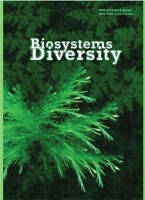East and West of the Carpathian Arc: Evidence of postglacial ecological and morphological divergence of Phytoecia tigrina metapopulations (Coleoptera, Cerambycidae)
East and West of the Carpathian Arc: Evidence of postglacial ecological and morphological divergence of Phytoecia tigrina metapopulations (Coleoptera, Cerambycidae)
Author(s): A. M. Zamoroka, A. Ruicănescu, C.-O. ManciSubject(s): Physical Geopgraphy, Environmental Geography, Environmental interactions
Published by: Дніпропетровський національний університет імені Олеся Гончара
Keywords: longhorn beetles; niche modelling; GIS; morphology; new taxa; biogeography; evolutionary history; LGM refugi;
Summary/Abstract: Phytoecia tigrina Mulsant (1851) is recognized as a species under strict protection EU Habitat Directive, it represents a focal point for conservation efforts across Europe. However, the dearth of comprehensive understanding regarding its biology, ecology, and geographical distribution poses formidable challenges to conservation endeavors. In the current study, we have delineated eight European and two Asian distinct metapopulations of Ph. tigrina across its geographic range, with a particular emphasis on elucidating its dispersion within the Circum-Carpathian region. This delineation serves to underscore the species' distribution, niche dimensions and limits of ecological tolerance that illuminate its adaptation capacity to diverse environmental conditions within the range. Our study has unveiled notable differentials in both morphological and ecological traits among Ph. tigrina metapopulations, notably between those located on the eastern and western flanks of the Carpathian Arc. Such differentials suggest the influence of divergent evolutionary trajectories, likely influenced by historical climatic changes during the Late Pleistocene and Holocene epochs. Significantly, specimens derived from eastern metapopulations exhibit morphological features of sufficient magnitude to warrant the proposition of a distinct subspecies, Phytoecia (Pilemia) tigrina podillica ssp. nov. This taxonomic delineation underscores the taxonomic complexity inherent within the Ph. tigrina species complex. Our investigations have further illuminated the historical dynamics of the species distribution, indicating the presence at least of two refugia during the Last Glacial Maximum (LGM). These refugial enclaves, situated in the Sea of Marmara/Eastern Aegean Sea region and the Pannonian Plain, likely played pivotal roles in shaping contemporary distributional patterns. Moreover, our ecological niche modeling endeavors have elucidated rapid expansions of suitable habitat for Ph. tigrina during post-glacial epochs, notably the Preboreal and Boreal periods. These expansions aligned with the rapid dispersion of its host plant Cynoglottis barrelierisupplying colonization of new territories in the face of the fast-changing post-glacial environment. Our study underscores the intricate interplay between evolutionary history, environmental dynamics, and imperatives for conservation Ph. tigrina. By elucidating these complexities, we endeavor to furnish a robust foundation for future conservation initiatives aimed at safeguarding this emblematic species and its associated habitats.
Journal: Biosystems Diversity
- Issue Year: 32/2024
- Issue No: 1
- Page Range: 12-29
- Page Count: 18
- Language: English

